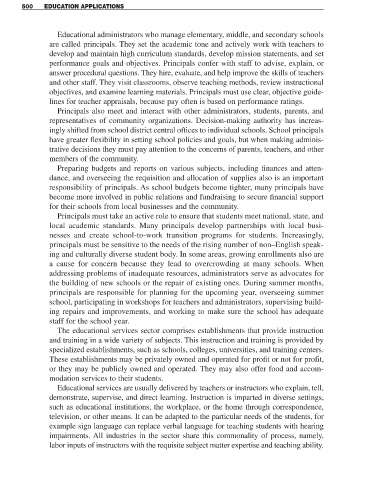Page 522 - Solid Waste Analysis and Minimization a Systems Approach
P. 522
500 EDUCATION APPLICATIONS
Educational administrators who manage elementary, middle, and secondary schools
are called principals. They set the academic tone and actively work with teachers to
develop and maintain high curriculum standards, develop mission statements, and set
performance goals and objectives. Principals confer with staff to advise, explain, or
answer procedural questions. They hire, evaluate, and help improve the skills of teachers
and other staff. They visit classrooms, observe teaching methods, review instructional
objectives, and examine learning materials. Principals must use clear, objective guide-
lines for teacher appraisals, because pay often is based on performance ratings.
Principals also meet and interact with other administrators, students, parents, and
representatives of community organizations. Decision-making authority has increas-
ingly shifted from school district central offices to individual schools. School principals
have greater flexibility in setting school policies and goals, but when making adminis-
trative decisions they must pay attention to the concerns of parents, teachers, and other
members of the community.
Preparing budgets and reports on various subjects, including finances and atten-
dance, and overseeing the requisition and allocation of supplies also is an important
responsibility of principals. As school budgets become tighter, many principals have
become more involved in public relations and fundraising to secure financial support
for their schools from local businesses and the community.
Principals must take an active role to ensure that students meet national, state, and
local academic standards. Many principals develop partnerships with local busi-
nesses and create school-to-work transition programs for students. Increasingly,
principals must be sensitive to the needs of the rising number of non–English speak-
ing and culturally diverse student body. In some areas, growing enrollments also are
a cause for concern because they lead to overcrowding at many schools. When
addressing problems of inadequate resources, administrators serve as advocates for
the building of new schools or the repair of existing ones. During summer months,
principals are responsible for planning for the upcoming year, overseeing summer
school, participating in workshops for teachers and administrators, supervising build-
ing repairs and improvements, and working to make sure the school has adequate
staff for the school year.
The educational services sector comprises establishments that provide instruction
and training in a wide variety of subjects. This instruction and training is provided by
specialized establishments, such as schools, colleges, universities, and training centers.
These establishments may be privately owned and operated for profit or not for profit,
or they may be publicly owned and operated. They may also offer food and accom-
modation services to their students.
Educational services are usually delivered by teachers or instructors who explain, tell,
demonstrate, supervise, and direct learning. Instruction is imparted in diverse settings,
such as educational institutions, the workplace, or the home through correspondence,
television, or other means. It can be adapted to the particular needs of the students, for
example sign language can replace verbal language for teaching students with hearing
impairments. All industries in the sector share this commonality of process, namely,
labor inputs of instructors with the requisite subject matter expertise and teaching ability.

